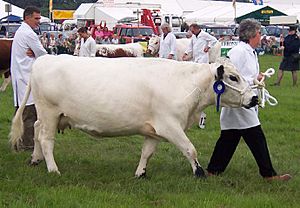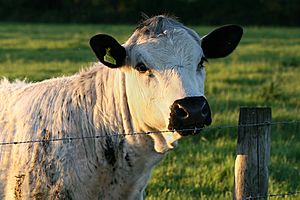British White cattle facts for kids
The British White is a special type of cattle from Britain. These cows are easy to spot because they are mostly white with dark ears, noses, and feet. They are also naturally hornless, which means they are born without horns. British Whites are mainly raised for their meat. People have known about this breed for a very long time, going back to the 1600s!
Contents
What Makes British White Cattle Special?
British White cattle have short, white hair. They have dark "points," which means their ears, feet, eyelids, nose, and sometimes even their teats are colored. This color is usually black, but sometimes it can be red.
These cattle are naturally polled, meaning they don't grow horns. They are medium-sized and have a strong, compact body shape. You might see a few colored spots on their white fur. The skin under their fur is usually dark grey or reddish, or pink with colored spots.
Black or Red Points?
About two out of every 100 British Whites have red points instead of black. This is because the red color is a recessive gene. This means that even some black-pointed animals might carry the gene for red points.
When British Whites are bred with other types of cattle, their special color pattern often shows up strongly in the calves. The hornless trait is also dominant, so the calves will usually be hornless too.
Tough and Thrifty Animals
British White cattle are known for being very hardy and good at finding their own food. They can easily graze on tough plants like rushes, nettles, or heather. They also enjoy eating leaves and twigs from many trees and bushes. Farmers like them because cows rarely have trouble giving birth to their calves.
A Look at Their History
White cattle, often with dark ears, were thought to be very important in Britain and Ireland a long time ago. For many centuries, herds of white cattle were kept in special parks. They were used for decoration and for hunting. These old white cattle led to the horned White Park cattle and also helped create the hornless British White breed.
However, British Whites are not as genetically different from other British breeds as White Parks are. This suggests that other breeds, like the Shorthorn, might have also played a part in their development.
Where Did They Come From?
These cattle were once kept in the park of Whalley Abbey in England. Later, in the early 1800s, a large part of the herd moved to Norfolk. This herd was then sold in smaller groups, mostly to rich families nearby. These cattle became the foundation for the British White breed we know today.
By the early 1900s, there were only about 130 registered British White cattle left. Most of them were in the eastern parts of England. But by the end of the 1900s, their numbers grew! There were over 1,500 registered animals in the UK and about 2,500 in the United States. Many British Whites also live in other countries, like Australia, where they were first brought in 1958. Today, the UK Rare Breeds Survival Trust lists them as a "minority" breed, meaning their numbers are still quite low.
Who Looks After the Breed?
In Britain, the British White Cattle Society keeps track of all the purebred British White cattle. In the past, British Whites and White Parks were listed together in the same record book.
In Australia, the British White Cattle Society of Australia manages the breed. They published their first record book in 1985.
In North America, there are two different groups that represent the breed: the British White Cattle Association of America and the American British White Park Association. It can be a bit confusing because the second group does not include the horned White Park cattle.
Other Similar Cattle Breeds
There are a few other cattle breeds that look a bit like the British White:
- The White Park is very similar. It's also white with black or red points, but it has white horns with dark tips. It's usually a bit taller and has fewer spots than the British White. Other related types include the Chillingham and Vaynol cattle.
- Fjäll cattle from Sweden are a dairy type that can also have colored points.
- The Irish Moiled is a traditional breed from Northern Ireland. It can be white with red points, but it's usually lighter and more of a dairy type than most British Whites.
- The Belgian Blue is often mostly white with grey ears. However, this breed is very muscular and used for intensive beef production, which is different from the British White.
- Holstein cattle can sometimes be almost all white and have black ear tips. These are dairy cattle, very different from the British White.
- The White Galloway is a white version of the Galloway breed with dark points.



